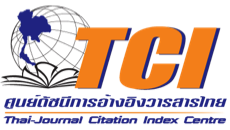ACCESS TO EDUCATION FOR MIGRANT CHILDREN: CHALLENGES AND OPPORTUNITIES IN SAMUT SAKHON PROVINCE
DOI:
https://doi.org/10.14456/tisr.2025.31Keywords:
Myanmar Migrant Workers, Educational Opportunities, Migrant Children, Samut Sakhon Province, Access to EducationAbstract
This article explores educational opportunities for children of Myanmar migrant workers in Samut Sakhon Province. It aims to examine the background of migration and the processes through which these children access education. This qualitative research uses in-depth interviews and focus group discussions with 30 stakeholders, including government officials, NGOs, and Myanmar migrant workers. The findings reveal that the migration of Myanmar workers is influenced by economic and social factors, with Thailand being a destination due to better economic opportunities. These children access education through public schools and community learning centers. However, barriers persist, such as documentation limitations and parental attitudes. Promoting educational opportunities for these children aligns with the United Nations Sustainable Development Goals, particularly reducing inequalities and ensuring quality education. Providing education to migrant children enables them to develop essential skills and integrate into the labor market effectively, which helps reduce child labor and supports decent employment.
Downloads
References
Apisith, P. (2022). Migrant labor policy in Thailand: The impact of government amnesty programs. Bangkok: Institute of Social Policy Studies.
Banks, J., & Banks, C. (2016). Multicultural Education: Issues and Perspectives (9th ed.). New Jersey: John Wiley & Sons, Inc.
Bourdieu, P. (1986). The Forms of Capital. In J. Richardson. (ed.). Handbook of Theory and Research for the Sociology of Education (pp. 241-258). New York: Greenwood.
Freire, P. (1996). Pedagogy of the Oppressed. London: Penguin.
International Labour Organization. (2017). Thailand: Annual report on migration and employment. Geneva: International Labour Organization.
Labour Protection Network Foundation. (2024). Educational access for migrant children in Thailand: Policy challenges and recommendations. Samut Sakhon: Labour Protection Network Foundation.
Lavin, D. (2003). Changing attitudes toward educational equity: Higher education and social mobility. Massachusetts: Harvard University Press.
Lee, E. (1966). A theory of migration. Demography, 3, 47-57.
Mekong Migration Network. (2020). Migration and labour in Thailand: A study of the situation of Myanmar migrant workers. Chiang Mai: Mekong Migration Network.
National Education Act 1999, as amended by (No. 2) 2002 and (No. 3) 2010.
National Statistical Office. (2021). National statistical report on foreign workers in Thailand. Bangkok: National Statistical Office.
National Statistical Office. (2022). Annual report on migrant labor registration and nationality verification process in Thailand. Bangkok: National Statistical Office.
Nussbaum, M. (2011). Creating Capabilities: The Human Development Approach. Massachusetts: Belknap Press.
Piketty, T. (2014). Capital in the Twenty-First Century. Massachusetts: Harvard University Press.
Samut Sakhon Provincial Statistical Office. (2022). Statistics on registered migrant workers in Thailand. Samut Sakhon: Samut Sakhon Provincial Statistical Office.
Santasombat, Y. (2008). Transnational migration and social space: The making of migrant identities. Bangkok: Chulalongkorn University Press.
Sen, A. (1999). Development as freedom. Oxford: Oxford University Press.
The National Labour Research Center. (2022). Cross-border employment of migrant workers in Thailand: Policies and economic impact. Bangkok: Ministry of Labour.
The United Nations Children's Fund. (2019). Children on the move: Challenges and opportunities for migrant children in Thailand. Bangkok: UNICEF Thailand.
United Nations. (2015). Transforming our world: The 2030 agenda for sustainable development. New York: United Nations.

Downloads
Published
How to Cite
Issue
Section
License
Copyright (c) 2025 Authors

This work is licensed under a Creative Commons Attribution-NonCommercial-NoDerivatives 4.0 International License.









.png)


